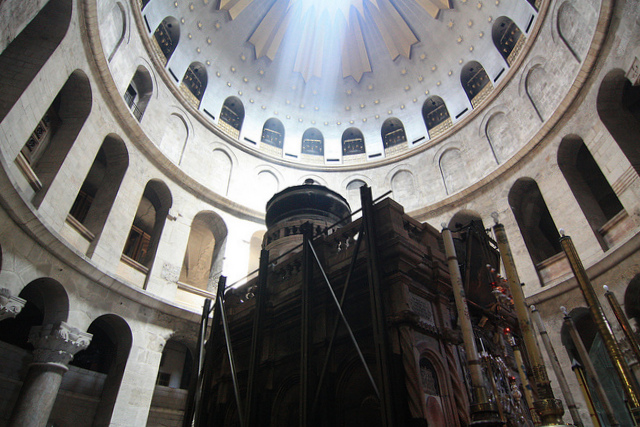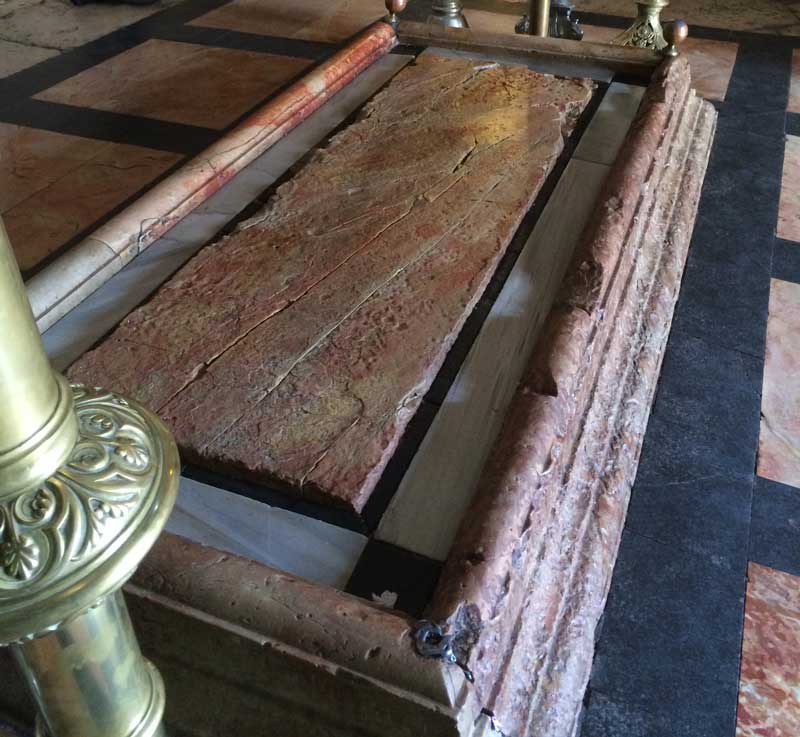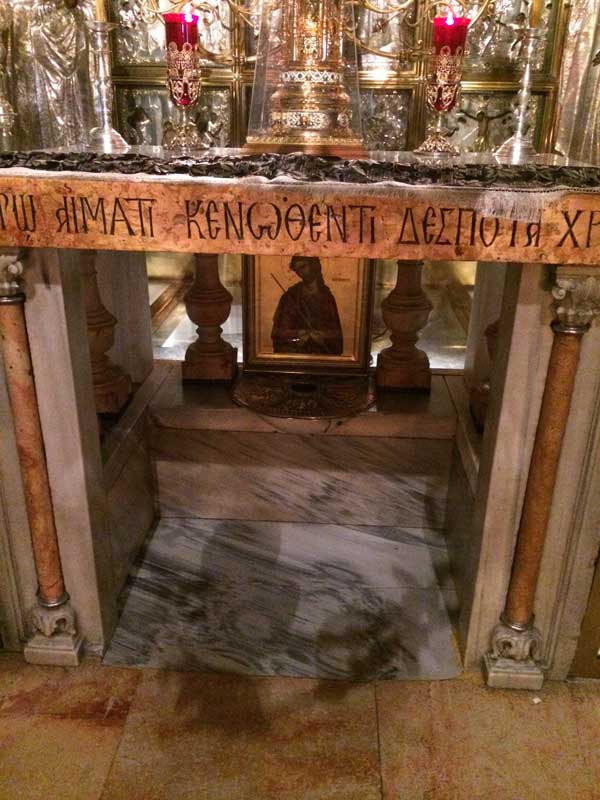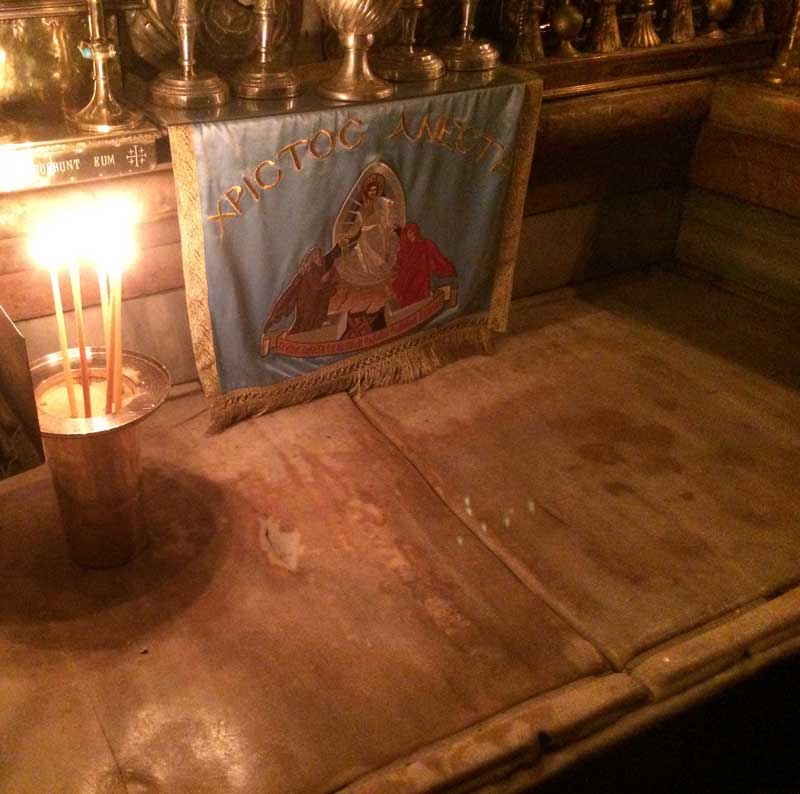The Church of the Holy Sepulcher

The dome of the Church of the Resurrection with the Aedicule, which covers the actual tomb of Christ.
Pope Francis and Ecumenical Patriarch Bartholomew will meet at the same three venues as their predecessors, Pope Paul VI and Ecumenical Patriarch Athenagoras in 1964. The three venues (in order) are the Apostolic Delegation, the Church of the Holy Sepulcher, and the Summer Residence of the Patriarchate of Jerusalem in Small Galilee. Pope Francis and Ecumenical Patriarch Bartholomew will also visit additional venues in the Holy Land as part of their separate itineraries. Below is a description of three venues: The Church of the Holy Sepulcher, Little Galilee, and the Church of the Nativity in Bethlehem.
By Anna Koulouris, Greek Orthodox Patriarchate of Jerusalem
Also called the Church of the Anastasis (i.e. Resurrection), the Church of the Holy Sepulcher is the most important site in Christendom. The structure, which has been destroyed by invaders and rebuilt by the Greek (Rum) Orthodox Christians, with cooperation of the emperors throughout the ages, holds within it the authentic places of Jesus Christ's crucifixion and resurrection. Renovations and restorations have been made as recently as the last two centuries, and even presently.

The stone where the body of Christ
was anointed before burial.
Photo courtesy of Theo Nicolakis.
Upon entering the Church, there lies the stone where the body of Christ was anointed before burial. A colorful mosaic behind the anointing stone illustrates the events leading up to the resurrection.

Mosaic icon of the burial of Christ
at the Church of the Holy Sepulcher.
Photo courtesy of Theo
Nicolakis.
To the right, up a steep stairway, one comes upon Golgotha, also known as the "place of the skull," where Jesus was crucified.

The site of the crucfixion of Christ on Golgotha in the Church of the Anastasis (Holy Sepulcher). Photo courtesy of Theo Nicolakis.
According to tradition, this is the skull of Adam, buried there by Noah after the flood brought the ark to its resting place. By divine providence, the messiah was crucified in the same spot, his blood symbolically washing away the sin of Adam. At each side of the altar, preserved behind glass, lies the stone from the original site. Underneath the altar table, thousands of people each day venerate the hole in the ground where the True Cross once stood.
Down the stairs, to the left side of the anointing stone stands the aedicule marking the site of the tomb where Jesus Christ was buried after his crucifixion. Thousands of people come to venerate and visit the site each year. As the main custodians of the shrine, the Brotherhood of the Holy Sepulcher, the monastic order of the Greek Orthodox Church, ensures that the shrine remains open to all people regardless of ethnicity or religion.

The tomb of Christ, draped with an
embroidered icon that says, "Christ is
risen!"
Photo courtesy of Theo Nicolakis.
Across from the All-Holy Tomb is the Greek Orthodox katholikon, which is centered in between dreadful Golgotha and the Life-Giving Tomb, and is the largest church in the Holy Sepulcher. Liturgies are celebrated throughout the week, including nighttime vigils, in both Golgotha and the Tomb. Holy Week and Pascha are the culmination of the entire ecclesiastical year, especially in the Holy Land. At the Church of the Holy Sepulcher, the ceremony of the Holy Light is watched by the world. It is a miraculous event in which the Greek Orthodox Patriarch enters the empty aedicule wearing only a white garment, and is sealed inside, where he prays. Throughout history, an unexplained fire has spontaneously lit the candles of the Patriarch, or sometimes pilgrims waiting outside. The fire, which jubilantly announces the resurrection, is shared with the other five Christian representations of the Holy Sepulcher and is also carried to every corner of the globe.
Other important sites within the Church of the Holy Sepulcher include the prison of Christ, where Jesus was held before being led to Golgotha for crucifixion, the site of his flagellation and the crowning of thorns. The sound of whipping and grunting has reportedly been heard by pious Christians who venerate the site, especially on Great Holy Friday. Down a stone stairway, deep within the enormous structure of the church, lies a cave-like chapel marking the place where St. Helen found the True Cross. A piece of the Cross can be found inside the office of the Church of the Holy Sepulcher, open for all to venerate, as well as significant relics from saints such Mary Magdalene, St. John the Baptist, St. Basil the Great, St. Panteleimon, as well as many others.
Although invaders throughout the centuries wreaked havoc on the original, once larger structure, the magnificence of the church lies in its enormity. It encapsulates within its great stone walls, the sites where God, through his own sacrifice, offered salvation to his entire creation.
